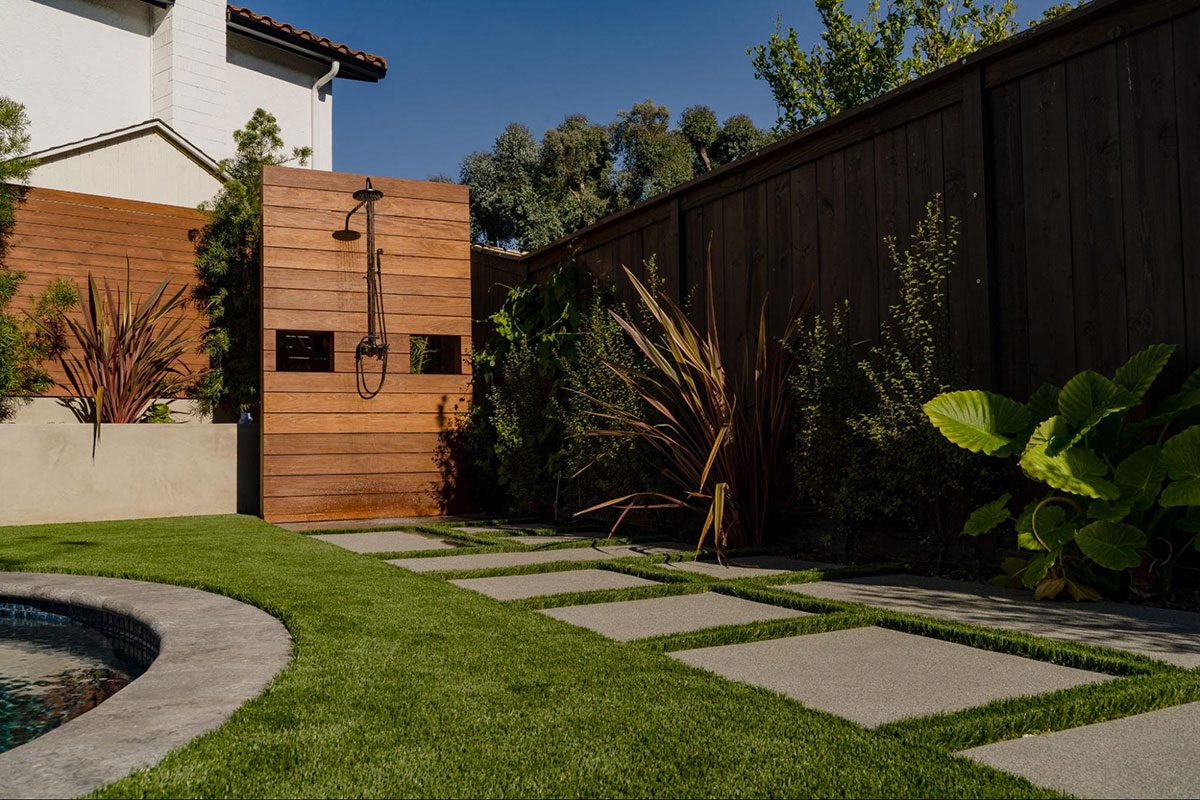As more and more people become aware of the benefits of artificial turf, the debate over artificial grass vs real natural grass has become a popular topic. While there are certainly benefits to both options, we at Artificial Turf Supply believe that synthetic grass can offer significant advantages over natural grass. In this blog, we’ll explore the pros and cons of each option and help you make an informed decision.
Artificial grass vs real grass
Artificial grass, also known as synthetic turf, is made from synthetic fibers designed to mimic the look and feel of real grass. On the other hand, real grass is a living organism that requires regular maintenance to stay healthy and vibrant.
Comparing Synthetic Turf vs. Natural Grass Benefits
| SYNTHETIC GRASS | NATURAL GRASS |
|---|---|
| UTILITY | |
| Artificial turf can accommodate sustained use, even under environmental stresses, amounting to 8-12 times the annual use of a natural grass surface. | Requires recovery between events, after rainfall, watering & for maintenance activities. In optimal conditions, it can only accommodate 1/10th (10%) of the activity a synthetic surface can endure. |
| APPEARANCE | |
| Artificial grass turf will appear as a well-maintained and groomed grass-playing surface with minimal effort. | Requires regimented maintenance for best appearance. May discolor or die in unsightly patches. |
| SAFETY | |
| Even, consistent surface lends to fewer injuries over natural grass. All-rubber infill material softens impact, provides positive traction and a better, more consistent Gmax rating. About 40% fewer injuries observed in independent study. | Uneven surface, which could compact to hard, high impact areas or slippery, unpredictable mud conditions. Lower, less consistent Gmax rating, higher abrasion and presence of such hazards as irrigation system appurtenances compromise safety. |
| PERFORMANCE | |
| Faster playing surface throughout field with consistent, enhanced traction. Balls will react similarly to well-groomed grass, providing realistic play athletes expect. | Inconsistent & sometimes-patchy growths can cause unpredictable ball movements & leave those playing vulnerable to injuries from unexpected & inconsistent surfaces. |
| WARRANTY | |
| Along with wholesale artificial grass prices, an 15-Year insurable, manufacturer’s warranty or 10-year extended warranty is available. | Rarely warranted, except for quality of original installation. |
Where you can install artificial turf:
- Playgrounds
- Lawns and landscaping
- Indoor and outdoor sports
- Gym flooring
- Around pool decks
- For dogs and other pets
- Putting greens
Benefits of fake grass
One of the biggest benefits of artificial grass is that it requires very little maintenance. Unlike real grass, which needs to be watered, mowed, fertilized, and weeded, synthetic turf only needs to be brushed or rinsed occasionally to keep it looking its best. This means you can save significant time and money on lawn care.
Another benefit of fake grass is that it requires no water. This is particularly important in areas with limited water resources or in drought-prone regions where water conservation is a top priority. Synthetic turf can also be a good option for areas with poor soil quality or harsh weather conditions, as it doesn’t require the same nutrients and care as real grass.
Finally, artificial grass is incredibly durable and can withstand heavy foot traffic, making it an ideal choice for high-traffic areas like playgrounds or sports fields. It’s also resistant to fading, making it a good option for areas with a lot of sun exposure.
Benefits of real grass

While artificial grass certainly has its benefits, there are also some benefits to choosing real grass. One of the biggest advantages of real grass is its natural beauty. There’s no denying that a lush, green lawn can be a stunning addition to any home or property.
Real grass also has a number of environmental benefits. It helps to absorb carbon dioxide, filters pollutants from the air and water, and provides habitat for wildlife. Additionally, real grass provides a soft and cushioned surface, making it a great option for outdoor activities like picnics, frisbee, or just lounging in the sun.
Drawbacks of fake grass and real grass
While there are certainly benefits to both options, there are also some drawbacks to consider.
One of the main drawbacks of artificial grass is that it can fade over time, especially if it’s exposed to a lot of sunlight. Additionally, it can wear down over time, making it look less natural. To mitigate these issues, choosing a high-quality product and installing it correctly is important.
On the other hand, one of the main drawbacks of real grass is that it requires regular watering and maintenance to stay healthy. This can be time-consuming and costly, especially in areas with limited water resources. Also, real grass can be prone to pests and diseases, requiring additional care and attention.
Tips for mitigating drawbacks
To mitigate the drawbacks of each option, there are a few tips to keep in mind.
If you choose artificial grass, choose a high-quality product designed to withstand wear and tear. Ensure it’s installed correctly to minimize the risk of fading or damage. If you choose real grass, water it properly and fertilize it regularly to keep it healthy. Additionally, look for pests and diseases, and take steps to prevent them before they become a problem.
The choice between artificial grass vs real grass ultimately comes down to your specific needs and preferences.
Athletic Field Turf vs. Residential Artificial Grass: What’s the Difference?
Whichever style of artificial grass you need, you’ll find they all share a number of advantages over real grass: better resilience, low maintenance, and cost-effectiveness to name a few. So why are there so many different styles? What does each style do better than the other? For athletic and residential artificial grass, the answer is clear.
Today we’re looking at some of the things that make these two types of artificial grass distinct. Both have unique qualities that make them ideal for their intended uses, whether that’s for having local football games or completing the idyllic look of a new suburban home.
Athletic Turf: Sturdy and Yielding
Athletic turf is hands-down the best artificial grass for sports use. It’s commonly used for football and baseball, but soccer is also a popular choice. These sports require a playing field that is soft enough to cushion players yet is strong enough to withstand high contact use, game after game.
Athletic turf is designed with non-abrasive fibers to protect players from injury when sliding, tackling, or falling. Athletic artificial turf has a range of fiber styles that provide different levels of thickness and resilience for sports use. There is also special golf turf with smaller fibers to replicate putting greens and fringe. Sports artificial turf replaces real grass to eliminate the high costs of maintaining these fields.
Residential Artificial Grass: Vibrant and Comfortable
Residential artificial turf does not have to meet the same demands for strength as athletic turf. While athletic turf provides a playing surface, residential turf focuses on maintaining its healthy appearance all year round.
Every fiber of residential artificial turf is designed to look like real grass. Many residential turf styles have different colors and shapes of grass fibers to give yards, gardens, and lawns a natural look and feel. Although it was not made to withstand the kind of high contact use that sports turf needs, make no mistake—residential artificial turf is still made with long-lasting materials. Like athletic sports turf, residential artificial turf has resistance to UV rays and weather.
Athletic and Residential: A Turf for Every Use
The flexibility of fake grass makes it great for just about any need, making it an ideal alternative to real grass. Fake grass is a cost-effective solution whether you need a new playing field or a waterless front lawn. Whatever the differences between them, you now know all the styles of fake grass will offer you unique advantages.
Related resources:
- Where you can use artificial grass
- Cost of artificial grass
- How to choose the best artificial grass
- How to clean artificial grass
- Water bill savings with artificial grass
- How long does artificial turf last?
- Artificial turf supplies
- Pros and cons of artificial grass
- Artificial grass installation guide
- Does artificial grass fade?
- Does artificial grass need water?
- How to install artificial turf



